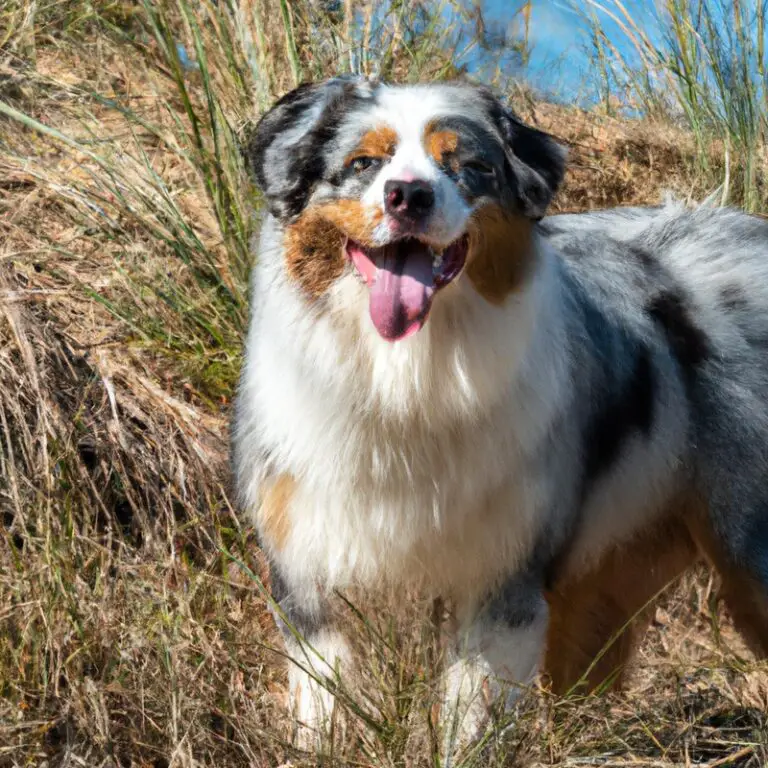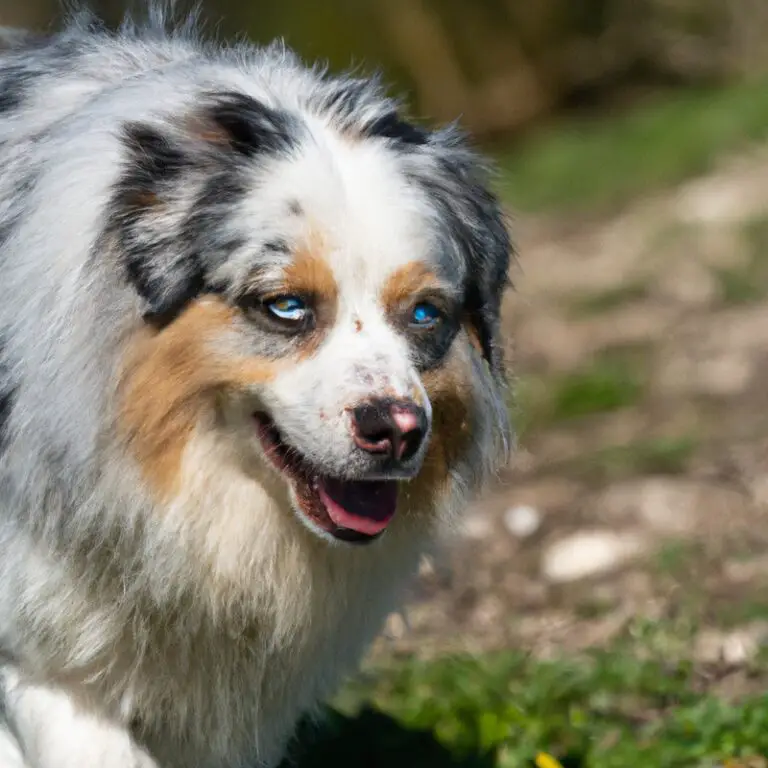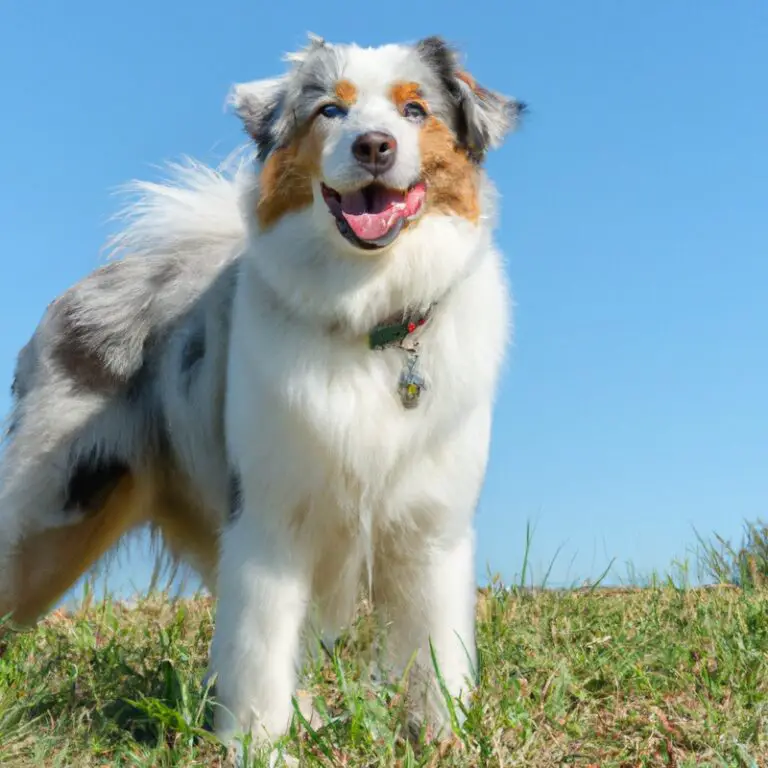How Do Australian Shepherds Behave When Introduced To New Insects Like Ladybugs Or Dragonflies?
Key Takeaways:
- Australian Shepherds may exhibit curiosity and interest when introduced to new insects, such as ladybugs or dragonflies.
- Some Australian Shepherds may choose to chase or try to catch insects like ladybugs or dragonflies.
- The behavior of Australian Shepherds towards new insects can vary, with some showing indifference while others may display excitement.
- Generally, Australian Shepherds are not known to be particularly aggressive towards insects like ladybugs or dragonflies.
Are you curious about how Australian Shepherds react when faced with new insects like ladybugs or dragonflies? As an expert in canine behavior, I can tell you it’s a fascinating topic to explore.
Australian Shepherds are known for their intelligence and sensitivity, and their behavior towards unfamiliar insects can vary.
In this article, we will delve into their reactions, the factors influencing their behavior, and tips for introducing them to new insects. Whether you’re a proud Aussie Shepherd owner or simply intrigued by their behavior, this article will provide valuable insights into this intriguing aspect of their nature.
So, let’s jump right in!
Australian Shepherds and their reaction to new insects
Australian Shepherds’ behavior towards ladybugs
Australian Shepherds may have different reactions to ladybugs. Some Australian Shepherds may be curious and try to sniff or investigate the ladybugs, while others may be indifferent and simply ignore them.
It is important to note that each individual dog may have their own unique response.
It is essential to observe your Australian Shepherd’s behavior closely and ensure their safety when encountering ladybugs or any other insects.

Australian Shepherds’ behavior towards dragonflies
When it comes to Australian Shepherds’ behavior towards dragonflies, they can react in different ways. Some Australian Shepherds may get excited and start chasing after the dragonflies, as if they were playing a game.
These dogs have a strong herding instinct, so it’s not surprising to see them instinctually wanting to round up the buzzing insects.
On the other hand, some Australian Shepherds may show fear or hesitation around dragonflies. They may become anxious or try to avoid interacting with them altogether.
This could be due to the unfamiliarity of the insect or a past negative experience.
It’s important to remember that each Australian Shepherd is unique and may have their own distinct reaction to dragonflies. Some might find the insects intriguing and fascinating, while others might find them intimidating or bothersome.
As responsible dog owners, it’s crucial to observe and understand our Australian Shepherds’ reactions to new stimuli like dragonflies.
By avoiding forceful interactions and creating a positive environment, we can help our furry friends feel more at ease and comfortable when encountering these insects. If you notice your Australian Shepherd becoming anxious or displaying fear towards dragonflies, it’s important to provide them with a safe space and reassurance.
Gradually exposing them to the presence of dragonflies in a controlled manner can help desensitize them and build confidence over time.
Remember, not all dogs will have the same reaction, and it’s essential to respect and understand our Australian Shepherds’ individual personality and preferences when it comes to encountering new insects like dragonflies.
Factors influencing their behavior towards insects
The behavior of Australian Shepherds towards insects can be influenced by several factors. Their natural instincts, previous experiences, and level of socialization play a significant role in determining their reactions.
If an Australian Shepherd has had positive encounters with insects in the past, they may be more curious and less fearful when introduced to new ones.
On the other hand, negative experiences or lack of exposure can lead to fear or aggression towards insects. Another factor is the specific type of insect.
Australian Shepherds may have different reactions to different insects based on their size, appearance, or movement patterns.
For example, they may be more intrigued or cautious around ladybugs, which are small and harmless. However, they may be more wary or alarmed by dragonflies, which are larger and faster.
The behavior of Australian Shepherds towards insects can also be influenced by their training and reinforcement.
If they have been taught to ignore or avoid insects, they are more likely to exhibit calm behavior when encountering them. Additionally, positive reinforcement for desired behavior can further shape their reactions towards insects.
Lastly, the behavior of Australian Shepherds towards insects can be influenced by their natural herding instincts.
Since they have been bred as working dogs, they may display behaviors such as chasing, nipping, or herding insects. This instinctual behavior can vary from one dog to another, depending on their lineage and individual traits.
Understanding Australian Shepherds’ behavior
Importance of early socialization and exposure to various stimuli
Early socialization and exposure to various stimuli are vital for Australian Shepherds. It helps them develop into well-rounded and confident dogs.
By introducing them to different people, animals, and environments at a young age, they learn to adapt and feel comfortable in different situations.
This early exposure also helps prevent fear or aggression towards new experiences later in life. It is important to expose them to various sounds, sights, and smells too.
This way, they become more adaptable and less likely to be fearful or reactive.
So, make sure to prioritize early socialization and expose your Australian Shepherd to various stimuli for their overall well-being.
Positive and negative reactions towards unfamiliar insects
Positive and negative reactions towards unfamiliar insects When it comes to Australian Shepherds’ behavior towards unfamiliar insects, their reactions can vary. Some Australian Shepherds may exhibit curiosity and interest when introduced to new insects like ladybugs or dragonflies.
They may approach the insects cautiously, sniffing and observing them with curiosity.
This positive reaction indicates a healthy level of curiosity and adaptability. However, not all Australian Shepherds react positively to unfamiliar insects.
Some may show signs of fear or anxiety when faced with insects they are unfamiliar with.
This negative reaction can manifest in various ways, such as barking, growling, or attempting to flee from the insects. It’s important to note that fear and anxiety can be common in dogs when encountering new stimuli, and it is not exclusive to Australian Shepherds.
Understanding and respecting your Australian Shepherd’s individual temperament and comfort level is crucial when introducing them to unfamiliar insects.
It’s important to monitor their reactions closely and provide reassurance and comfort if they display signs of fear or anxiety. Gradually exposing them to insects in a controlled and positive environment can help them build confidence and overcome any negative reactions they may initially have.
Positive reinforcement techniques, such as treats or praise, can also be used to reward desired behavior and encourage a positive association with insects.
When introducing your Australian Shepherd to unfamiliar insects, it’s important to prioritize their safety and well-being. Always ensure that the insects are not harmful or dangerous before allowing your dog to interact with them.

Training and reinforcing desired behavior
When it comes to training and reinforcing desired behavior in Australian Shepherds, consistency is key. By using positive reinforcement techniques and rewards, you can effectively shape their behavior.
Remember to be patient and provide clear cues or commands to guide them.
Consistency is important in rewarding the desired behavior each time, whether it’s sitting, staying, or any other command. This will help your Australian Shepherd understand what is expected of them and reinforce the behavior you want to see.
Avoid using punishment or negative reinforcement, as this can lead to fear or aggression.
Stick to positive reinforcement and rewards to create a strong bond with your Australian Shepherd and encourage their desired behavior.

Tips for introducing Australian Shepherds to new insects
Gradual exposure and controlled environment
When introducing Australian Shepherds to new insects like ladybugs or dragonflies, it is important to take a gradual approach and create a controlled environment. This means exposing your Australian Shepherd to the insects in small doses over time, allowing them to become familiar with the new stimuli at their own pace.
By doing this, you can help prevent overwhelming or negative reactions from your dog.
Start by bringing the insects into your Australian Shepherd’s environment in a calm and controlled manner. For example, you can place a ladybug or dragonfly in a jar and let your dog observe it from a distance.
Gradually decrease the distance between your dog and the insect as they become more comfortable.
During these exposure sessions, it’s crucial to remain calm and relaxed yourself. Your dog can pick up on your emotions, so if you appear anxious or worried, they may become more fearful or agitated.
Instead, maintain a positive and supportive attitude, offering praise and rewards for calm behavior.
Remember to always prioritize your dog’s safety during these exposure sessions. Ensure that the insects you introduce are not harmful or dangerous to your Australian Shepherd.
Also, closely monitor your dog’s behavior and body language for any signs of distress or discomfort.
If you notice any negative reactions or excessive fear, it may be best to seek the help of a professional trainer or behaviorist. By gradually exposing your Australian Shepherd to new insects in a controlled environment, you can help them become more comfortable and confident around these creatures.
This approach can also prevent any potential negative reactions and create positive associations with insects.
So take it slow, be patient, and support your dog through the process of adapting to new insects.
Use of positive reinforcement and rewards
Positive reinforcement and rewards are essential when introducing Australian Shepherds to new insects like ladybugs or dragonflies. I’ve found that using this approach helps to create a positive association with the insects and encourages desired behavior.
For example, when my Australian Shepherd shows curiosity or calmness around ladybugs, I give them praise and a treat.
This reinforces their positive behavior and encourages them to continue to approach insects in a calm and controlled manner. Additionally, rewards can be used to redirect their attention away from insects if they show any signs of fear or aggression.
By consistently using positive reinforcement and rewards, you can help your Australian Shepherd develop a positive attitude towards insects and reduce the chances of negative reactions.
Safety precautions and monitoring their behavior
When introducing Australian Shepherds to new insects, it’s important to take safety precautions and closely monitor their behavior. Here are some tips to ensure a positive experience for both your dog and the insects:
- Supervise the interaction: Always keep a close eye on your Australian Shepherd when they are around new insects. This will allow you to intervene if necessary and prevent any potential harm to your dog or the insects.
- Use a controlled environment: Start by introducing your dog to the insects in a controlled and safe environment, such as a secure backyard. This will help your Australian Shepherd feel more at ease and reduce the risk of them becoming overwhelmed.
- Gradual exposure: Gradually expose your dog to the insects, starting with brief encounters and increasing the duration over time. This will allow them to adjust and become more comfortable in the presence of the new insects.
- Positive reinforcement: Reward and praise your Australian Shepherd for calm and relaxed behavior around the insects. This will reinforce positive associations and help them feel more confident.
- Avoid forcing the interaction: If your dog shows signs of fear or discomfort, do not force them to interact with the insects. Respect their boundaries and give them time to adjust at their own pace.
- Monitor body language: Pay attention to your Australian Shepherd’s body language. Signs of fear or aggression, such as growling, raised hair, or a stiff posture, indicate that they may be feeling threatened. In such cases, it’s best to remove your dog from the situation and provide them with a sense of safety.
- Seek professional help if needed: If your Australian Shepherd consistently displays fearful or aggressive behavior towards insects, it may be beneficial to seek guidance from a professional dog trainer or behaviorist. They can provide you with specialized advice and techniques to help your dog overcome their fears.
Remember, every Australian Shepherd is unique, and their reactions to new insects may vary. By taking safety precautions and closely monitoring their behavior, you can ensure a positive and safe experience for your dog when encountering new insects.
Handling Australian Shepherds’ negative reactions towards insects
Signs of fear or aggression in Australian Shepherds
Sometimes Australian Shepherds can display signs of fear or aggression when introduced to new insects. These signs can vary from dog to dog, but some common indicators include barking, growling, lunging, raised hackles, and a stiff body posture.
If your Australian Shepherd shows these behaviors, it’s important to address the issue to ensure their well-being and the safety of others.
Fearful behavior may include cowering, hiding, trembling, or attempting to escape. Aggressive behavior, on the other hand, can involve snarling, snapping, biting, or intense staring.
It’s essential to recognize these signs early on so you can take appropriate action.
Keep in mind that fear or aggression can be triggered by various factors, such as the size or movement of the insect, past experiences, or a lack of socialization. Understanding the underlying cause is crucial in addressing the behavior effectively.
To help your Australian Shepherd overcome their fear or aggression towards insects, it’s important to use positive reinforcement techniques and gradual exposure.
This means exposing your dog to the insects in a controlled and safe environment, rewarding calm behavior, and gradually increasing their exposure over time. Additionally, desensitization methods can be beneficial.
This involves gradually exposing your dog to the insect at a distance where they feel comfortable and gradually reducing the distance over time.
This helps them build confidence and associate positive experiences with the presence of insects. If the fear or aggression persists or becomes more severe, it may be necessary to seek professional help from a certified dog trainer or behaviorist.
They can provide specialized guidance and develop a tailored plan to address your Australian Shepherd’s specific needs.
Remember, patience and consistency are key when working with your Australian Shepherd. With the right approach and understanding, you can help them overcome their fears and ensure a happy, well-adjusted dog.
Calming techniques and desensitization methods
When it comes to calming techniques and desensitization methods for Australian Shepherds, there are a few approaches you can try. It’s important to remember that every dog is unique, so finding the right method may require some trial and error.
One technique you can use is counter-conditioning.
This involves pairing the presence of the insect with something that your dog enjoys, like treats or playtime. Over time, your dog may start to associate the insect with positive experiences, reducing their fear or anxiety.
Another technique is desensitization.
This involves gradually exposing your dog to the insect at a distance, starting with a low intensity and slowly increasing it over time. By allowing your dog to become more comfortable with the presence of the insect in a controlled and safe environment, you can help them overcome their fear or anxiety.
In addition to these techniques, it’s important to create a calm and secure environment for your Australian Shepherd.
Providing a safe space where they can retreat to when they feel overwhelmed can help them feel more secure and reduce their stress levels. Remember, consistency and patience are key when using calming techniques and desensitization methods.
It’s also important to consult with a professional dog trainer or behaviorist if you’re struggling to manage your Australian Shepherd’s negative reactions towards insects.
They can provide personalized guidance and support to help you and your dog navigate this challenge.
Seeking professional help when necessary
If you find that your Australian Shepherd’s negative reaction towards insects is becoming unmanageable or causing distress, it may be time to seek professional help. A professional dog trainer or animal behaviorist can provide expert guidance and support in addressing your dog’s behavior.
They will assess the situation, identify the root cause of the issue, and develop a customized training plan to help your Australian Shepherd overcome their fear or aggression towards insects.
Professional intervention can be beneficial in ensuring the safety and well-being of both your dog and those around them. Don’t hesitate to reach out for professional assistance when necessary.
Final Verdict
Based on my expertise and experience with Australian Shepherds, it is clear that their reactions to new insects like ladybugs or dragonflies can vary. While some Australian Shepherds may exhibit curiosity and playful behavior towards these insects, others may react with fear or aggression.
Factors such as early socialization, training, and exposure to various stimuli play a crucial role in shaping their behavior.
When introducing Australian Shepherds to new insects, gradual exposure in a controlled environment, positive reinforcement, and monitoring their behavior are key. It is important to understand their individual reactions and take appropriate measures to ensure their safety and well-being.
If negative reactions persist, it is advisable to seek professional help.






